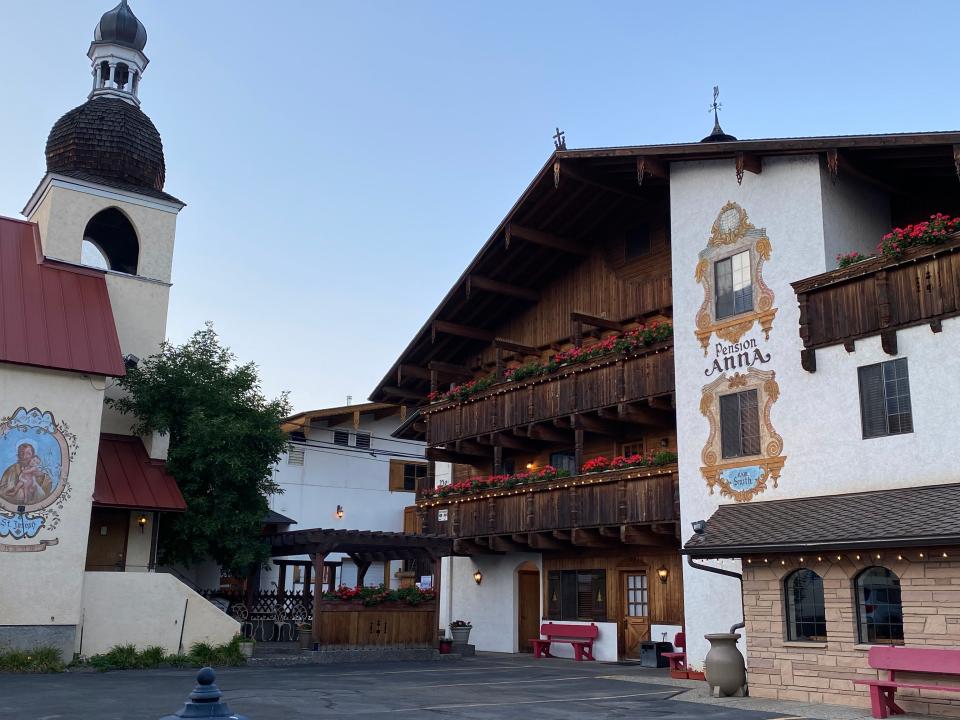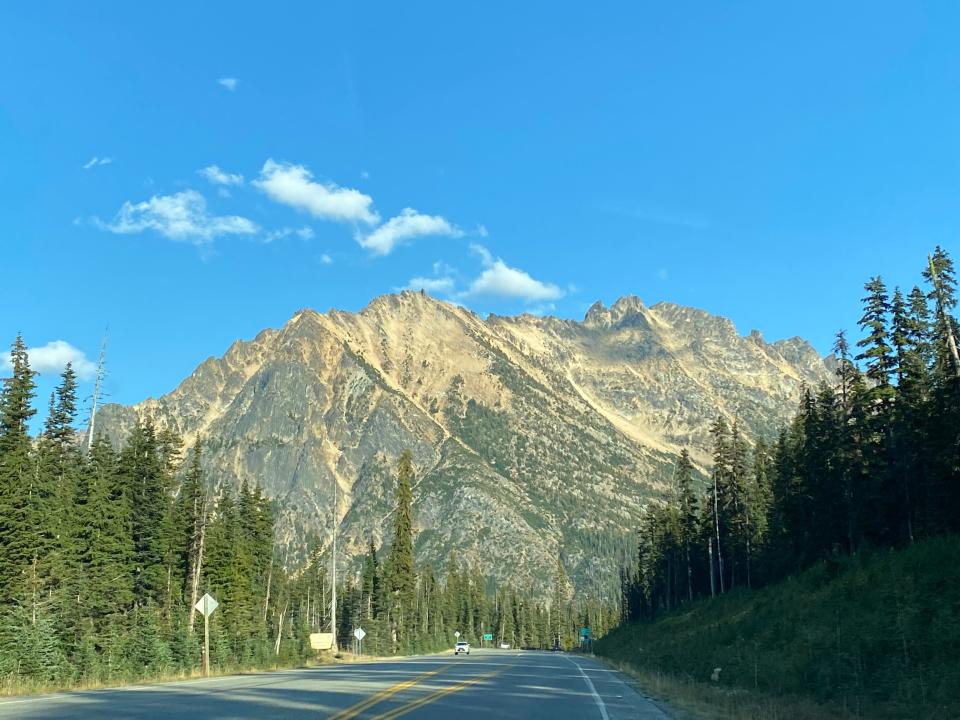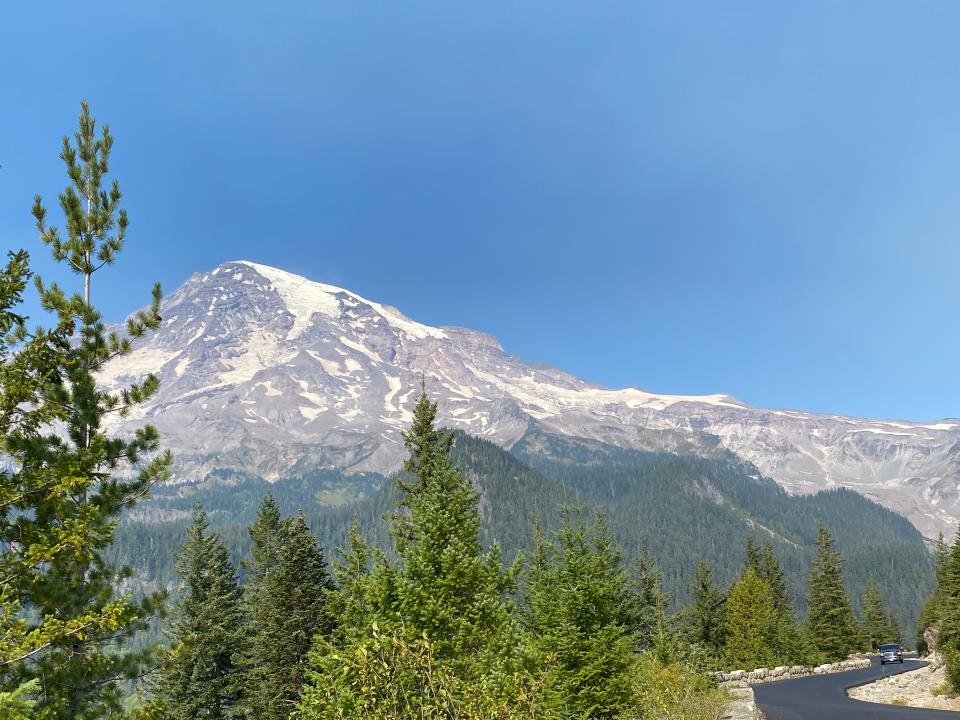Travel: Overwhelmed by beauty in the Enchantments and Washington’s national parks
LEAVENWORTH, Wash. – With a name like the Enchantments, how could we resist?
That’s the name of an over-the-top spectacular region within the Alpine Lakes Wilderness of the Cascade Mountain Range, located about 70 miles east of Seattle.
“It’s so beautiful everywhere up there, you don’t know where to begin to look,” said Erika Szuster, co-owner of Pension Anna, a delightful, Bavarian-themed hotel in Leavenworth.
Experienced hikers in the Pacific Northwest rave about the Enchantments, an alpine paradise of crystal-blue lakes and glacier-carved granite peaks. The hike through the core Enchantments zone follows a 21.1-mile point-to-point trail and requires more than 14 hours of strenuous hiking.
Our goal, Colchuck Lake, technically sits at the doorstep of the Enchantments. To enter into the core area, we would have had to continue up the punishing Aasgard Pass, which rises more than 1,900 feet in less than a mile.
The 4.1-mile hike to Colchuck Lake would provide all of the challenges we needed. By the time we strapped on our daypacks for this trek, we had already hiked in three national parks in Washington: Mount Rainier, Olympic, and North Cascades.
A religious experience
“Extremely challenging” is the rating given the Colchuck Lake Trail on several hiking websites. The trail climbs an elevation of 2,280 feet, often seemingly straight up. For a mile and a half, we enjoyed the gradual ascent with the sounds of Mountaineer Creek coming through the dense forest. The trail soon turned into a tangle of roots, rocks and boulders that made it a mistake to take our eyes off the ground.
We rock-hopped over one creek and surmounted boulders to reach a sturdy log bridge. The path steepened, and we took to all fours struggling up rock fields. Switchbacks were plentiful, but not hazardless.
Gray jays perched on nearby Douglas firs and cedars looking for handouts. They seemed to be mocking our ground-bound efforts.
Orcas and art:To find relaxation, visit the San Juan Islands in Washington State
As the climb wore on mercilessly, we asked hikers heading downhill how much trail remained, only to receive sad-eyed replies of “an hour, perhaps more.” One downhill hiker groused, “It’s beautiful up there, but I was almost too tired to enjoy it.”
The trail dipped into a small swale, and then suddenly, we landed at one of the finest vistas in the Cascades. It had taken more than four hours to do four miles, but we made it to Colchuck Lake, and the panorama supplied the promised payoff. We entered a hidden, enchanted place.
The lake’s icy water reflected the twin spires of Dragontail and Colchuck peaks. To the left of the 8,840-foot Dragontail massif, we spotted other hikers continuing up to Aasgard Pass. Remnants of the Colchuck Glacier clung to the slopes. The lake appeared bright emerald from the broad granite face where we rested and devoured our lunches.

Our return trek was a less time-consuming, but perhaps more treacherous endeavor as we carefully scrambled over roots and rocks, the mountain’s efforts to trip us and send us tumbling.
The end of the day brought a stroll through Leavenworth, a Bavarian-themed village offering German cuisine, including big pretzels and locally crafted beers. After our adventure on the Colchuck Lake Trail, we had some of everything and relished our experience in the “American Alps.”
North Cascades National Park
Before reaching Leavenworth, we traveled on the North Cascades Scenic Highway, or State Route 20, through North Cascades National Park. The national park is known primarily as a backpacker destination because large regions are accessible only on foot. However, State Route 20’s scenic overlooks, such as Diablo Lake and Ross Lake, show off the best of Cascades scenery. Short and long trails for hikers of all abilities allow for venturing off this main thoroughfare and into the wild.

Behind the North Cascades Visitor Center near Newhalem, the 1.8-mile River Loop Trail weaves through a forest of hemlocks, cedars, and firs to reach the Skagit River, which rockets past at a whitewater clip. The easy, fully-accessible Gorge Creek Falls Trail provides a view of the 242-foot cascade. Happy Creek Forest Walk involves a short stroll on an elevated wooden pathway through a forest of ancient trees. The mile-long Rainy Lake Trail slips through a forest of mountain hemlock, Pacific silver fir, and Engelmann spruce before reaching a mist-cloaked lake.
Mount Rainier National Park
Watching the sun go down over Mount Rainier glowingly concludes a perfect day. The deck of Paradise Inn is one of the best viewing platforms for the snowy peak in Mount Rainier National Park. The historic lodge rests in Paradise amid subalpine meadows. Naturalist John Muir once called these wildflower meadows “the most luxuriant and the most extravagantly beautiful of all the alpine gardens I have beheld.” Beginning in the spring, more than 40 species of wildflowers open up their technicolor blossoms. Visitors traipse through the meadows on a paved, 6.2-mile Skyline Loop Trail.
Immense wilderness:Drink in the beauty of Glacier National Park at the Many Glacier Hotel
At nearly 240,000 acres, Mount Rainier National Park is the nation’s fifth oldest national park, designated so by Congress in 1899. Rising three miles into the sky, the iconic mountain is the tallest volcano in the Cascade Mountain Range and is the most glaciated peak in the continental United States.
To enter the park, we followed the Nisqually River and reached Longmire. The buildings that house the Longmire Visitor Center have welcomed guests since the 1880s. A hotel, museum, general store and even a one-time gas station are part of the village. Across the street, the short Trail of the Shadows wends through thick forest to the old Longmire homestead, mineral springs and a beaver pond. A short distance away, the Carter Falls Trail, a section of the 93-mile Wonderland Trail, reaches Carter Falls and Madcap Falls, just 50 yards apart on the Paradise River. Driving east toward Paradise, we reached Christine Falls, which drops 69 feet on Van Trump Creek. Narada Falls, like Christine Falls, is visible from the road as it plummets 168 feet over massive boulders.

At Sunrise Point, situated at an elevation of 6,400 feet, we took in views of the Emmons Glacier stretching across Mount Rainier’s northeastern slope. It is the largest glacier by area in the lower 48 states. From the Sunrise Visitor Center, we walked the Silver Forest Trail, one of the most scenic hikes in the 260-mile trail network.
Olympic National Park
“We are still relying so much on the moon,” said ranger Ellie Mondloch as she guided a beach walk to the tidepools at Kalaloch Beach on Olympic National Park’s Pacific Coast. The moon governs the rise and fall of the tide, creating the pools at low tide. Twice a day, sea creatures are viewable as the ocean pulls back its waves and exposes the tidepools.
Orange starfish, pale-green anemones, mussels, sea snails, and barnacles cling to rock outcroppings. Mondloch explained how these colorful, strange-looking creatures survive in their ever-changing tidal environment. We scanned the horizon for migrating grey whales and searched the waters for sea otters, harbor seals, and sea lions.
We stayed at Kalaloch Lodge, set on a bluff above the beach and inside the national park. Our days included long walks on the pebbly beach to experience the sounds, smells, and ruggedness of the Pacific Coast.
The 923,000-acre Olympic National Park protects about 73 miles of wilderness coast, but it also shelters the Hoh Rain Forest and the alpine meadows and peaks of the Olympic Mountain Range.
The Hoh Rain Forest receives a yearly average of 140 inches of rain. The Hall of Mosses Trail transported us beneath curtains of moss hanging from tree branches. Ninety species of mosses, ferns, and lichen thrive here alongside Sitka spruce, western hemlock, and other conifers. The rainforest shelters the largest unmanaged herd of native Roosevelt elk in the Pacific Northwest.
We left behind the rainforest and reached the alpine region by driving through Port Angeles and going south to the Hurricane Ridge Visitor Center. Before us, Mount Olympus rose 7,980 feet, making it the highest in the Olympic Mountains. To complement these stunning views, we hiked the Hurricane Hill Trail and peered across the Straits of Juan de Fuca in hopes of catching sight of Puget Sound and Vancouver Island, British Columbia.
Shimmering Lake Crescent illuminates long stretches of U.S. Highway 101. The deep, blue lake supplies the backdrop for a pleasant night’s stay at Lake Crescent Lodge, set inside the national park in the shadow of Mount Storm King. Kayaks and canoes are for rent next to a long fishing pier. Guests drink in the beauty from Adirondack chairs on the shady lawn beside the lake. The lodge’s restaurant offers a grand dining experience with comfortable décor and exquisite meals like grilled king salmon or thyme-roasted chicken.
Linda Lange and Steve Ahillen are travel writers living in Knoxville, Tenn.
This article originally appeared on Knoxville News Sentinel: Travel: Visit the Enchantments and Washington’s national parks

